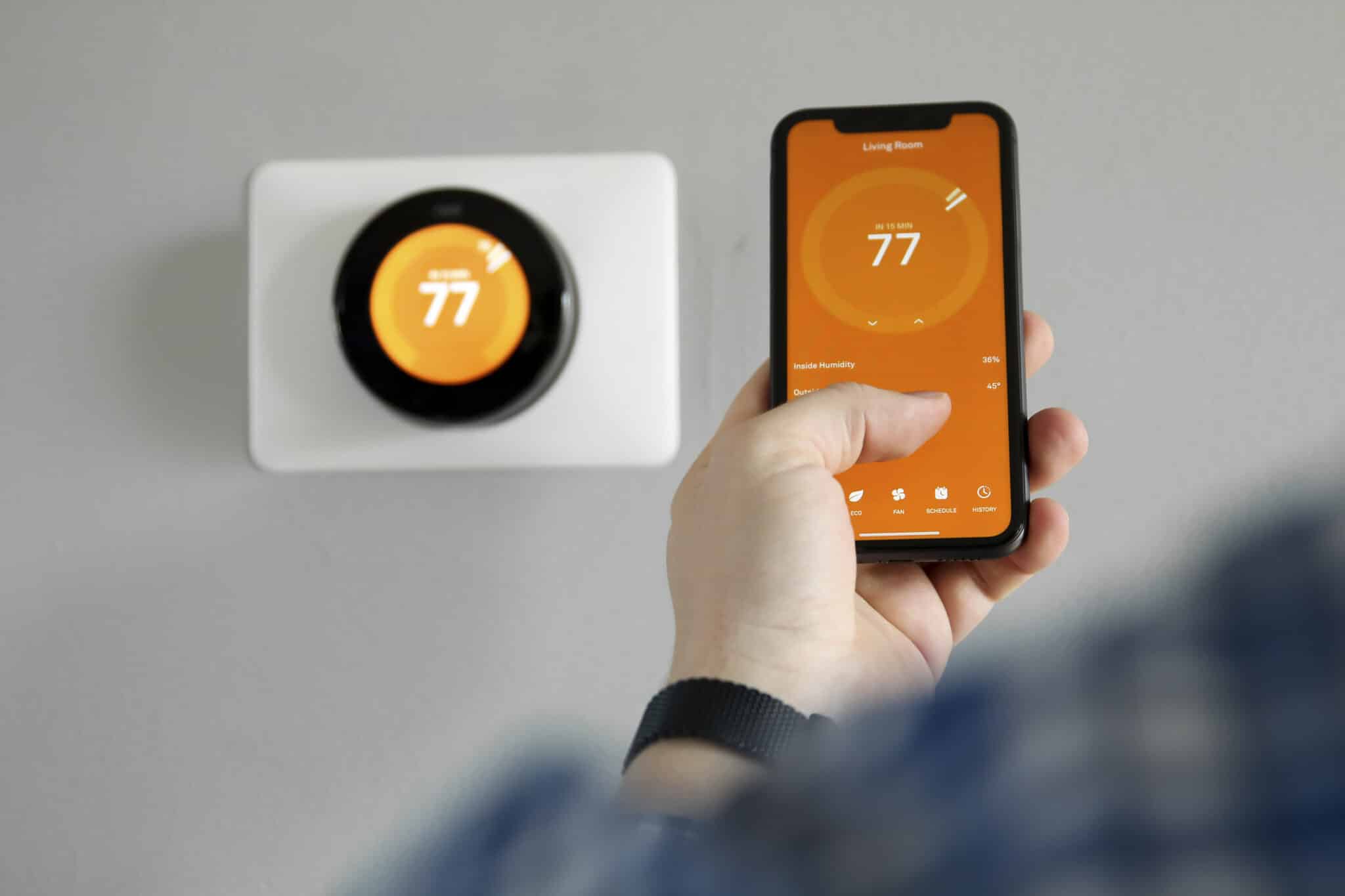Are you wondering if smart thermostats is really worth it for your home? With San Diego’s unique mix of sunny days and cool nights, finding the right temperature can be tricky. That’s where smart thermostats come in!
These handy gadgets make it easy to manage your home’s heating and cooling, helping you stay comfortable while saving energy. Whether you’re dealing with a warm summer day or a chilly evening, a smart thermostat can do the work for you — all with just a tap on your phone.
What is a Smart Thermostat?
Smart thermostats is a high-tech upgrade that does much more than just adjust your home’s temperature. It connects to your Wi-Fi, allowing you to control your heating and cooling through your smartphone, tablet, or voice assistant like Alexa or Google Home, no matter where you are.
These thermostats are designed to learn your daily habits and preferences, adjusting automatically to fit your lifestyle. For example, if you typically lower the heat at night and raise it in the morning, a smart thermostat will recognize this pattern and start doing it automatically, saving you time and effort.
With additional features like energy usage reports and scheduling, a smart thermostat helps keep your home comfortable while lowering energy consumption.

How Smart Thermostats Work
Smart thermostats operate by connecting to your home’s Wi-Fi, allowing you to control the temperature remotely using a smartphone app or a smart assistant. These devices use sensors and algorithms to monitor your daily habits, like when you wake up or leave for work, to adjust temperatures automatically.
For example, a smart thermostat can cool your house down before you arrive or lower the heat when you’re not at home to save energy.
Many smart thermostats also utilize geofencing, which means they can detect when you’re close to home and adjust settings accordingly. Over time, they continue learning and refining their settings to maintain an ideal indoor climate while minimizing energy usage.
The San Diego Climate: Why Smart Thermostats Matter
Understanding San Diego’s Climate
San Diego is known for its Mediterranean-like weather, featuring warm, dry summers and mild, wet winters. The average high temperature in summer can reach around 77°F, while winter lows can drop to around 50°F.
Because of this, residents often find themselves using air conditioning during the day and heating in the evening, even within the same season.
Humidity levels are generally low, but sudden coastal fog or heat waves can quickly change the comfort level in your home. These variations make traditional thermostats less efficient, as they can’t respond to changes as rapidly or precisely as a smart thermostat can.
Why Temperature Regulation Matters
Proper temperature regulation is essential in San Diego homes because it directly affects comfort, energy use, and even indoor air quality. Without an effective system, residents may experience hot or cold spots in their homes, making some rooms uncomfortable.
Additionally, constantly adjusting a manual thermostat can lead to higher energy bills and wear on your HVAC system. Smart thermostats eliminate these issues by learning your preferences and adjusting them automatically, which ensures consistent comfort while using less energy.
This adaptability is particularly useful in San Diego, where the weather can vary dramatically throughout the day. With a smart thermostat, you’ll enjoy stable indoor temperatures without lifting a finger.
Benefits of Smart Thermostats for San Diego Homes
Energy Savings and Lower Utility Bills
One of the biggest advantages of using a smart thermostat in San Diego is its ability to help reduce energy usage and lower utility bills. By learning your schedule and adjusting the temperature automatically, these devices prevent your HVAC system from running when it’s not needed.
For instance, during cooler evenings, the smart thermostat can turn off the air conditioning and switch to natural ventilation, saving energy without sacrificing comfort.
Many smart thermostats also offer detailed energy reports, showing exactly where you can make improvements to save even more. This makes it easier to optimize your energy use and see a return on your investment within a short period.
Enhanced Comfort Control
Smart thermostats provide advanced features like multi-room temperature sensors, which allow you to maintain different temperatures in different parts of your home. This is particularly useful in larger homes or multi-level properties where the upstairs and downstairs areas can vary greatly in temperature.
Additionally, smart thermostats let you set personalized schedules for weekdays and weekends, ensuring your home is always at the perfect temperature when you need it.
With the ability to fine-tune your home’s climate settings, you can avoid overheating or overcooling and experience consistent comfort throughout the day. This level of customization is something that traditional thermostats simply can’t match.
Remote Access and Monitoring
Remote access is a game-changer for homeowners in San Diego who are always on the go. Smart thermostats connect to your smartphone through an app, allowing you to adjust the temperature from anywhere, whether you’re at work, running errands, or on vacation.
This is particularly useful if you forget to turn off the AC before leaving or want to cool down your home before arriving on a hot day. You can also monitor your home’s temperature in real-time and receive alerts if it gets too hot or too cold.
With remote access, you have total control over your home’s climate no matter where you are, providing peace of mind and added convenience.
Features of Smart Thermostats
Learning Capabilities and Adaptability
One standout feature of these devices is their ability to learn and adapt to your daily routine. They use sensors and algorithms to understand when you’re typically home when you leave, and what temperatures you prefer throughout the day.
Over time, this helps the system create a personalized heating and cooling schedule that maximizes both comfort and energy efficiency.
For example, if you usually turn the temperature down at bedtime, the thermostat will start doing this automatically. Additionally, if your routine changes, the device can update its schedule based on your new habits, ensuring it remains accurate and efficient.
Integration with Home Automation Systems
These thermostats can seamlessly integrate with other smart devices in your home, such as voice assistants, smart lights, and security systems. This allows you to create a connected ecosystem where everything works together.
For example, you can set up routines that lower the temperature when you lock the front door or raise it when the garage door opens. Integration with platforms like Google Home and Amazon Alexa also means you can control your thermostat using voice commands, adding an extra layer of convenience.
This interconnected functionality not only simplifies home management but also improves overall energy efficiency.
Energy Usage Reports
These devices provide detailed energy usage reports that help you understand your heating and cooling patterns. These reports show how much energy you’re using, and when you’re using it, and offer suggestions for optimizing settings to save more. Some models even send you a monthly summary so you can see your progress over time.
This level of insight is invaluable for homeowners who want to cut down on energy costs without sacrificing comfort. By monitoring your usage, you can make informed decisions and adjust settings to align with your energy-saving goals.
How Smart Thermostats Contribute to Sustainability
Reducing Carbon Footprint
Using a smart thermostat can significantly cut down your home’s carbon footprint. Because these devices reduce energy use by efficiently managing your HVAC system, they contribute to lower greenhouse gas emissions.
For example, by using a smart thermostat to maintain a consistent temperature instead of frequently adjusting it, your heating and cooling systems run less often, which saves fuel and reduces CO2 output.
Even small changes, like turning down the heat when you’re away, can add up over time, making a big difference in your environmental impact. With more homeowners adopting smart thermostats, the collective reduction in emissions can be substantial.
Supporting Renewable Energy Sources
Some smart thermostats are compatible with renewable energy sources like solar or wind power. They can be set up to prioritize using these green energy options when they’re most available, helping to minimize reliance on non-renewable sources.
This is especially useful in a city like San Diego, where solar energy is abundant. Additionally, certain smart thermostats allow users to participate in demand-response programs, which adjust energy use during peak hours to reduce strain on the grid.
By syncing your thermostat with renewable energy and smart grid initiatives, you contribute to a more sustainable energy system and help promote the use of cleaner power.
Choosing the Right Smart Thermostat for Your Home
Key Features to Look For
When choosing a new model, certain features can make a big difference in performance and usability. Learning capabilities allow the thermostat to automatically adjust based on your daily habits, saving you time and energy.
Multi-zone support is essential if you want to control different rooms separately, providing more comfort throughout the house.
Compatibility with voice assistants like Alexa or Google Home is another great feature for hands-free control and added convenience. Additionally, energy usage tracking and monthly reports are helpful for monitoring and optimizing your energy consumption to help reduce costs.
Compatibility with Existing Systems
Before purchasing, it’s crucial to ensure that the thermostat is compatible with your home’s existing HVAC system. Some models require a “C-wire” for continuous power, which may be missing in older homes.
Always check your system’s wiring to determine if additional installation steps are needed or if a professional might be required. For homes with complex HVAC systems like multi-stage heating and cooling, choosing a model specifically designed for advanced setups will ensure the best performance and longevity.
User Interface and Display Options
User interface design plays a huge role in how easy it is to use your thermostat daily. Look for a model with a clear, intuitive display that makes temperature adjustments straightforward.
Some offer full-color touchscreens, while others may have basic digital screens. If you prefer hands-free control, prioritize models that can be operated via smartphone apps or voice commands. A well-designed interface means you’ll spend less time navigating settings and more time enjoying a comfortable home.
Smart Home Integration
If you already use other smart devices, it’s a good idea to choose a thermostat that integrates seamlessly with your existing setup. Devices that can connect with smart lights, cameras, and security systems will provide a unified smart home experience.
For example, some thermostats can trigger lighting changes when temperatures are adjusted or work with smart locks to manage energy use when the house is unoccupied. Consider how a new thermostat will fit into your overall smart home ecosystem to maximize convenience and control.
Installation Process for Smart Thermostats
DIY Installation vs. Professional Help
While it is possible for those with a knack for basic electrical tasks to install a smart thermostat themselves, opting for professional installation is strongly recommended.
Modern smart thermostats often come with support resources like manuals and online tutorials; however, the complexity of ensuring correct installation and calibration for optimal performance usually warrants expert handling.
Enlisting a professional ensures that the thermostat is integrated seamlessly with your home’s unique HVAC system, particularly if your setup is intricate.
This not only saves time but also safeguards against potential mishaps related to improper wiring or configuration, which could lead to costly repairs or inefficient energy use. Choosing professional installation is a prudent decision to maximize both functionality and efficiency.
What to Expect During Professional Installation
If you decide to go with professional installation, the process is typically quick and hassle-free. An HVAC technician will inspect your existing system, remove the old thermostat, and connect the new one to your heating and cooling system.
They will test the wiring and make sure everything is safely installed before turning the power back on. The technician will then guide you through setting up the smart thermostat’s basic settings, such as connecting it to your Wi-Fi network and downloading the companion app.
This service usually takes about an hour, and by the end, your smart thermostat will be fully functional and ready to use.
Common Misconceptions About Smart Thermostats
Despite their growing popularity, there are several misconceptions about smart thermostats that may deter homeowners from installing them. Here are some of the most common myths:
- Only beneficial for new homes or high-tech setups: Many believe smart thermostats are designed only for modern homes, but most models are compatible with older HVAC systems too.
- Difficult to install and require advanced technical skills: While some systems can be complex, many are straightforward enough for DIY enthusiasts with basic tools and a step-by-step guide.
- Don’t offer significant energy savings: Smart thermostats can reduce heating and cooling costs by up to 15% by optimizing temperature settings based on your schedule and preferences.
- Can’t function without Wi-Fi: If the Wi-Fi goes down, smart thermostats continue to operate normally, adjusting your home’s temperature based on stored settings.
- Too expensive to justify the cost: Although some models are pricier upfront, the energy savings typically offset the initial investment within a year or two.
Understanding these points can help homeowners see the real value smart thermostats bring, no matter the age or setup of their house.
Ready to Upgrade Your Home’s Comfort in San Diego?
Don’t let San Diego’s changing temperatures keep you uncomfortable. With the right thermostat, you can keep your home perfectly cozy and energy-efficient year-round!
Contact One Hour Heating & Air Conditioning San Diego today to learn how our expert team can help you choose and install the ideal device for your needs. Let’s make your home more comfortable and efficient, no matter the weather outside.

FAQs About Smart Thermostats
Are these devices worth the investment?
Yes, these devices can be a great investment due to their energy-saving features and convenience. They help optimize your home’s heating and cooling, which can reduce utility bills over time. Plus, the added comfort and control make them a valuable addition to any household.
Can I control my thermostat from my phone?
Yes, you can control it remotely through a smartphone app that syncs with your device. This allows you to adjust settings, create schedules, or turn off your system from anywhere. It’s convenient if you forget to make changes before leaving home. With just a few taps, you can manage your home’s climate with ease.
How do I know if my home is compatible?
Most homes work well with these devices, but it’s best to check your wiring and HVAC setup first. Many models require a “C-wire” (common wire) for power, which some older homes might lack. You can verify compatibility by checking your existing thermostat’s wiring or using an online compatibility tool.
Do they work with all heating and cooling systems?
They are designed to support a variety of systems, including forced air, heat pumps, and even multi-stage units. Some models are better suited for specific setups, so it’s important to verify compatibility before purchasing. Most manufacturers provide compatibility guides to help you choose the right option.
Are they difficult to use?
Not at all! Most are designed with intuitive touchscreens, user-friendly apps, and even voice control for easy management. Once set up, they learn your routine and automatically adjust based on your schedule. This reduces the need for manual adjustments and ensures your home stays comfortable.
























